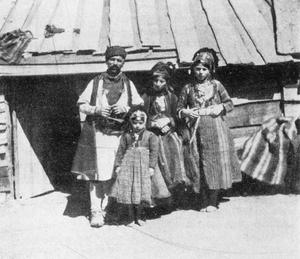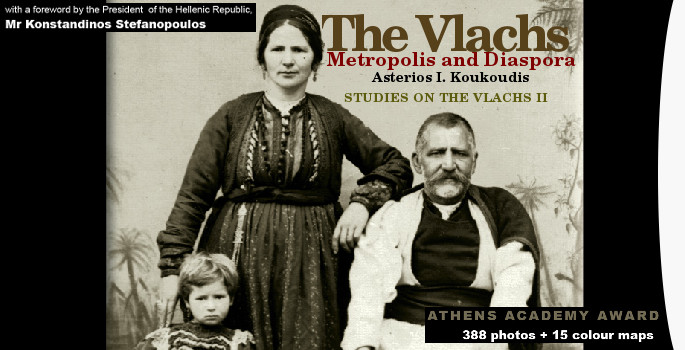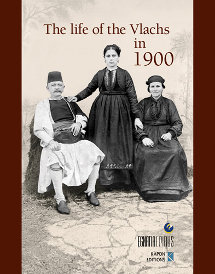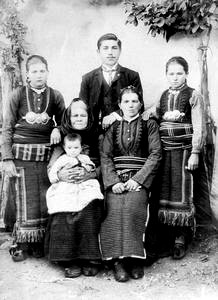THE VLACHS: METROPOLIS AND DIASPORA
VI. The Vlachs of Grammos
2.8.4. The diaspora and the colonies of the Grammoustian Vlachs
 It is worth mentioning, albeit briefly, the villages and the hut settlements which the Grammoustians colonised or established ― though they cannot be precisely dated, because the exoduses succeeded one another in waves. Grammoustian falkaria appeared in Krusevo and the surrounding area, seeking summer pastures, before the people of Nikolicë settled there. At first, when Krusevo was evolving into a village with a settled Vlach population, the Grammoustians lived there only in summer. Later on, during the nineteenth century, most of them abandoned transhumance and settled in Krusevo for good. A little to the south of Krusevo, a small settlement with an exclusively Vlach population was established and named Borino. Borino reportedly had about 100 families and a brief life-span, for an attack by Arnaut raiders sent the inhabitants fleeing to Krusevo, where they established a new district and named it Birina. Apparently, quite a number of the Grammoustians of Borino were not only stockbreeders but also excellent metalworkers. Two rather small, exclusively Grammoustian settlements were established at Carnus (or Mukos) and Kadijica near the Babouna pass between Prilep and Titov Veles. Carnus reputedly had the probably inflated number of 300–400 families of stockbreeders and caravan drivers and did not thrive. In around 1850, again after a predatory raid by Arnauts, this time from Shkodër, the Grammoustians of Carnus dispersed, and many of them went to Krusevo, Stip, and Tetovo. Those who settled in Tetovo apparently included some excellent gunsmiths.[1] Following the destruction of Carnus and Kadijica, some of the inhabitants probably went and joined the nomadic falkaria and the Grammoustian hut settlements in the more easterly parts of Macedonia. References to Grammoustian metalworkers and gunsmiths lend support to the view that Grammousta was not just a village of transhumant Vlach stockbreeders, but also had inhabitants who were engaged in commerce and craft trades. As we have seen, smaller groups of Grammoustians, mainly stockbreeders, helped to colonise Magarevo, and also Trnovo and Nizepole on Pelister, together with Vlach fugitives from other areas.
It is worth mentioning, albeit briefly, the villages and the hut settlements which the Grammoustians colonised or established ― though they cannot be precisely dated, because the exoduses succeeded one another in waves. Grammoustian falkaria appeared in Krusevo and the surrounding area, seeking summer pastures, before the people of Nikolicë settled there. At first, when Krusevo was evolving into a village with a settled Vlach population, the Grammoustians lived there only in summer. Later on, during the nineteenth century, most of them abandoned transhumance and settled in Krusevo for good. A little to the south of Krusevo, a small settlement with an exclusively Vlach population was established and named Borino. Borino reportedly had about 100 families and a brief life-span, for an attack by Arnaut raiders sent the inhabitants fleeing to Krusevo, where they established a new district and named it Birina. Apparently, quite a number of the Grammoustians of Borino were not only stockbreeders but also excellent metalworkers. Two rather small, exclusively Grammoustian settlements were established at Carnus (or Mukos) and Kadijica near the Babouna pass between Prilep and Titov Veles. Carnus reputedly had the probably inflated number of 300–400 families of stockbreeders and caravan drivers and did not thrive. In around 1850, again after a predatory raid by Arnauts, this time from Shkodër, the Grammoustians of Carnus dispersed, and many of them went to Krusevo, Stip, and Tetovo. Those who settled in Tetovo apparently included some excellent gunsmiths.[1] Following the destruction of Carnus and Kadijica, some of the inhabitants probably went and joined the nomadic falkaria and the Grammoustian hut settlements in the more easterly parts of Macedonia. References to Grammoustian metalworkers and gunsmiths lend support to the view that Grammousta was not just a village of transhumant Vlach stockbreeders, but also had inhabitants who were engaged in commerce and craft trades. As we have seen, smaller groups of Grammoustians, mainly stockbreeders, helped to colonise Magarevo, and also Trnovo and Nizepole on Pelister, together with Vlach fugitives from other areas.
It is difficult to be very specific about the Grammoustians’ highland summer hut settlements, owing to their very nature. They frequently broke up, and their population fluctuated, or else they were inhabited only for a few years. Some of these settlements evolved into permanent summer villages and organised highland communities. Most of them, however, until they were finally abandoned, remained simple summer hut settlements with a small population, and they very often do not appear in the various official and unofficial statistics. Nevertheless, I shall try to present them as fully as possible, at least as they had taken shape by around 1900.
The hut settlement near Ano Koryfi (Rodovo) was established in the Morihovo area on the south-eastern flank of Vorras, but it survived only until the end of the first decade of the twentieth century, when most of the families moved to Edessa. The settlements of Megala Livadia and Mikra Livadia were established on Païko, among the settled Moglena Vlachs, and began to take on the form of permanent semi-nomadic highland communities when the Grammoustians and a few refugees from Moschopolis settled there and were later joined by refugees from Perivoli and Samarina. We shall investigate the Rodovo and Livadia settlements in more detail later on.
A quite remarkable group of Grammoustian hut settlements sprang up in the more easterly parts of Macedonia, on the slopes of Orvilos or Pirin, and more specifically at Lopovo, Bazdovo, Satrovo, and Popovi Livadi in what is now Bulgaria, and Laïlias in Greece. There were also some smaller settlements, which will be discussed in another study. Another group of settlements was established in the Rodopi, where, after the borders were drawn in 1878, some remained in Ottoman territory and others found themselves in Eastern Rumelia. Pizdica, Kartal al Yanku, Cakmak, Krva Reka, Zalti Kamen, the hut settlement near Kostandovo, and the largest of the settlements, Bakica or Kurtovo, were in Eastern Rumelia. The Grammoustians in this group came to be known as ‘Kutruviani’, after the name of their largest settlement. According to Weigand, shortly before 1907 these settlements had about 305 huts altogether and a population possibly in excess of 2,000. On Ottoman territory, Grammoustian hut settlements were established at Karamandra and Sufandere, and also alongside the settlements of Belica, Goldovo, Dobarsko, Draglica, Jakoruda, and Bacevo, and near the market town of Razlog. This group of Grammoustians came to be known as ‘Razlukiani’. According to statistics collected by the Greek consular authorities in around 1906, it was about 2,000 strong.[2]
Another group came into being on Mount Rila, both on Ottoman and on Bulgarian territory. Some of the Grammoustians on Bulgarian territory had apparently passed through the Orvilos area first. The settlements there became permanent after Bulgarian autonomy was recognised in 1878. Ravna Buka, Besbunar, and Kostenec Banja were on Bulgarian territory; the summer hut settlements at Dobropole, Risovo or Hrisovo, Argacic, Bistrica, and Bakir Tepe, and the winter settlements at Blagoevgrad (Gorna Dzumaja), Strumski Ciftlik, Gramada, and Krupnik were on Ottoman territory. A few smaller falkaria also set up summer hut settlements on the western slopes of the Balkan Mountains, such as Ladzene near Anton in the area of Pirdop.[3] According to Weigand, the group on Rila was 1,500–2,000 strong. The Grammoustians who had their summer settlements in the mountains in Ottoman territory every winter inundated the plains along the Strymon, the Drama plain, and the low coastal areas between Ierissos and Porto Lagos in search of grazing grounds; while those in Bulgaria and Eastern Rumelia sought their winter pastures towards the Danube and along the Maritsa/Evros valley as far as Adrianople and the grasslands of Eastern Thrace.
Two hut settlements, Cernodol and Malesevo, were established on Ograzden and Kadijica in what is now Fyrom. There were a considerable number of summer hut settlements in the highland pastures on Osogovo, also in Fyrom, at Kalin Kamen, Kitka, Ponikva, Lopen, Jamiste, Kostarica (or Semeri), Ozdenica, Lisec, Stanci, and Duraska, and slightly further north, on German, were Bara, Vakuf, and Osice. There were at least two summer settlements on Mount Golak near Trsino. On Mount Plackovica, there were summer hut settlements at Catal Cesme, Lisec, Kartal, Cepino, Adjinica, Kukla, Kolarnica, Karatepe, Asanlija, Cokonica, Leonica, Blatec, and Teranci. According to Weigand, at the beginning of the twentieth century all these highland hut settlements together had 500 huts and possibly more than 3,000 inhabitants. According to a Greek consular document of the same period, there were 314 huts in all and possibly around 2,000 inhabitants.[4] In winter, they went down to the Kumanovo plain and along the Vardar/Axios valley to Kilkis, the lake basin of Lagadas, Kalamaria, and as far as Halkidiki. During the twentieth century, the population of these highland hut settlements gradually abandoned pastoral nomadism and eventually settled mainly in lowland villages and towns in the eastern provinces of Fyrom, most notably in the provinces of Kocani, Stip, Ovce Pole, and Titov Veles, along the valleys of the Vardar and its tributary Bregalnica.
To these settlements we must also add those which were established within the then borders of Serbia, between Pirot and Vranja, on the Stara Planina, Gaveska Planina, Sljep, Vidlic, and Suha Planina Mountains and as far as the slopes of Kapaonik on the Serbia–Kosovo border.[5] Towards the end of the nineteenth century, the falkaria on Kapaonik reportedly had 80,000 sheep and 2,000 pack-animals;[6] but they seem to have disappeared without trace.
Some of these settlements were large, with more than a hundred families, while others had no more than fifteen or twenty families. However, their great number and the extent of their dispersal alone gives us some idea of the astonishing magnitude of the population drain from Grammousta and the surrounding Vlach settlements on the slopes of Grammos. All this confirms the fact, that, until the late eighteenth century, Grammousta was indeed one of the largest Vlach communities. So it would be no exaggeration to say that, until the end of the eighteenth century, and even more so in the glory days before this, there were at least 3,000 families and possibly more than 15,000 souls living in Grammousta and its satellite settlements.







